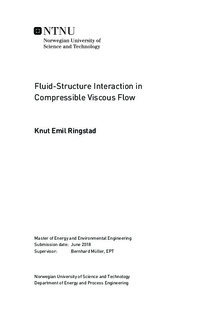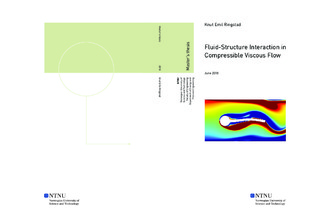| dc.description.abstract | In this master's thesis a ghost-point immersed boundary method for the compressible Navier-Stokes equations using higher order summation by parts operators is described and implemented for two-way coupled fluid-structure interaction (FSI). Two FSI problems are presented: a) an elastically mounted circular cylinder in free stream and b) an elastic plate attached to a stationary circular cylinder in channel flow.
a) An elastically mounted circular cylinder is modeled as a harmonic oscillator with two degrees of freedom. The harmonic oscillator system is coupled to the flow solver through the drag and lift forces acting on the cylinder and through the imposed boundary conditions at the immersed boundary. The results are compared against those of Yang and Stern [Yang, J., Stern, F., 2012. "A simple and efficient direct forcing immersed boundary framework for fluid-structure interactions". Journal of Computational Physics 231 (15), 5029-5061] at Re=200. The immersed boundary method (IBM) shows a good capability to describe this FSI problem. The harmonic oscillator system is solved numerically by the explicit Euler method and the classical explicit 4-stage Runge-Kutta method. A convergence study of the harmonic oscillator system gave an unexpectedly low order of convergence when external forces were applied. The transfer of energy between the fluid and structure is investigated for the elastically mounted cylinder in free stream.
b) An elastic plate behind a circular cylinder was modeled with the Euler-Bernoulli thin beam model for transverse motion. The plate was implemented with a higher order immersed boundary method to match the FSI benchmark by Turek and Hron [Turek, S., Hron, J., 2007. Proposal for Numerical Benchmarking of Fluid-Structure Interaction Between an Elastic Object and Laminar Incompressible Flow. Vol. 53.]. The systems are coupled through the immersed boundary and the pressure loads on the structure.
The results indicate that the IBM describe FSI problems with deformable bodies well compare to the benchmark at Reynolds numbers Re=20 and Re=100. The implementation of the pressure forces on the structure in the FSI coupling was found to cause amplifying errors which made the simulations unstable. | |

